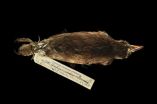(Press-News.org) BATON ROUGE – The Crab Nebula, once considered to be a source of energy so stable that astronomers used it to calibrate their instruments, is dimming. LSU physicists Mike Cherry, Gary Case and graduate student James Rodi, together with an international team of colleagues using the Gamma-ray Burst Monitor, or GBM, on NASA's Fermi gamma-ray space telescope, discovered the anomaly. This revelation has proven astonishing for astronomers.
The Crab Nebula, one of the most studied objects in the sky, is the wreckage of a star that exploded in 1054. Considered a cornerstone of astronomical research, it even inspired its own unit of measurement, the "millicrab," which is used as a standard for measuring the intensity from other high-energy sources.
The GBM instrument was launched into orbit in summer 2008. This summer, the scientists were working on a catalog of the high energy X-ray and gamma ray signals detected mainly from sources in the galaxy powered by black holes and neutron stars. As they were preparing the catalog, which has been accepted for publication in the Astrophysical Journal, they realized that the intensity coming from the Crab Nebula was dimming.
"We were using the Crab as our calibration source and comparing the other high energy sources to it," said Case. "But as we collected more and more data, we noticed that the intensity we were measuring for the Crab was going down. This was a rather startling discovery, and it took awhile for us to believe it."
The initial suspicion was that the instrument was losing sensitivity. The team then gathered data from three other sensitive X-ray and gamma ray observatories currently in orbit – NASA's Swift and Rossi X-Ray Timing Explorer, or RXTE, and the European Space Agency's International Gamma-Ray Astrophysics Laboratory, or INTEGRAL. The result was that all four instruments were seeing the same decrease in intensity of about 7 percent since the summer of 2008.
"Nearly every other source of high energy radiation in the sky shows evidence of explosive, time-variable, transient activity. The Crab was the exception," said Cherry. "It was the only object that was bright enough and steady enough to serve as a 'standard candle.'"
Colleen Wilson-Hodge, an astrophysicist at NASA's Marshall Space Flight Center in Hunstville, Ala., recently presented the findings at the American Astronomical Society meeting in Seattle.
"Now, for the first time, we're clearly seeing how much our candle flickers," she said. The findings will be published in the Astrophysical Journal Letters.
Additional analysis showed that the Crab Nebula has brightened and dimmed several times since 1999 on approximately a three-year time scale. The current decrease is the largest so far observed, and the international team will continue to monitor the Crab Nebula to observe how much the decline continues.
The cause of the changes is not understood, but apparently involves changes in the magnetic fields close to the nebula's central neutron star. Because of this news, the scientists said that astronomers will now need to find new ways to calibrate their instruments in flight and to explore the possible effects of the inconstant Crab Nebula emissions on past findings.
###
About NASA's Fermi:
NASA's Fermi is an astrophysics and particle physics partnership managed by NASA's Goddard Space Flight Center in Greenbelt, Md., and developed in collaboration with the U.S. Department of Energy, with important contributions from academic institutions and partners in France, Germany, Italy, Japan, Sweden and the United States. For more information, visit www.nasa.gov/Fermi.
Contact Ashley Berthelot
LSU Media Relations
225-578-3870
aberth4@lsu.edu
Lynn Chandler
NASA's Goddard Space Flight Center
301-286-2806
lynn.chandler-1@nasa.gov
More news and information can be found on LSU's home page at www.lsu.edu
END
A research team from across the United States and Ecuador has pinpointed 1898 as the year the avipoxvirus, or avian pox, hit the Galapagos Islands and started infecting its birds. This estimation is vital to understanding avian diseases that affect today's Galapagos birds. The scientists' paper on the subject, "110 Years of Avipoxvirus on the Galapagos Islands," will be published on January 13 in PLoS ONE, an international, open-access science publication.
The research team, led by Dr. Patricia Parker of the University of Missouri–St. Louis, examined 3,607 finches and ...
A new Chandra X-ray Observatory image of Messier 82, or M82, shows the result of star formation on overdrive. At a distance of only 12 million light years, M82 provides a unique cosmic laboratory for studying conditions similar to those that existed billions of years ago when stars were forming at a furious rate in most galaxies.
M82 is a so-called starburst galaxy, where stars are forming at rates that are tens or even hundreds of times higher than in a normal galaxy. The burst of star birth may be caused by a close encounter or collision with another galaxy, which ...
DURHAM, N.C. — Researchers at the Duke Cancer Institute who have been studying prostate cancer cells for decades now think they know why PSA (prostate-specific antigen) levels reflect cancer progression.
"This is the first demonstration of a mechanism that explains why PSA is a bad thing for a tumor to produce," said senior author Sal Pizzo, M.D., Ph.D., chair of the Duke Department of Pathology. "I am willing to bet there is also a connection in cancerous cell growth with this particular biological signaling mechanism happening in other types of cells."
Using human ...
GALVESTON, TX – Drugs that pharmaceutical companies market most aggressively to physicians and patients tend to offer less benefit and more harm to most patients — a phenomenon described as the "inverse benefit law" in a paper from the University of Texas Medical Branch at Galveston.
Published online Thursday, Jan. 13 in the American Journal of Public Health, the article explores recent withdrawals of blockbuster drugs due to safety concerns and finds a clear pattern of physician-focused marketing tactics that ultimately exposed patients to a worsening benefit-to-harm ...
The American Heart Association today issued a call to action for the public, health professionals, the food industry and the government to intensify efforts to reduce the amount of sodium (salt) Americans consume daily.
In an advisory, published in Circulation: Journal of the American Heart Association, the association sets out the science behind the American Heart Association's recommendation for the general population, which is to consume no more than 1500 milligrams (mg) of sodium a day because of the harmful effects of sodium – elevated blood pressure and increased ...
New NASA satellite data indicate the current La Niña event in the eastern Pacific has remained strong during November and December 2010.
A new Ocean Surface Topography Mission (OSTM)/Jason-2 satellite image of the Pacific Ocean that averaged 10 days of data was just released from NASA. The image, centered on Dec. 26, 2010, was created at NASA's Jet Propulsion Laboratory (JPL), Pasadena, Calif.
"The solid record of La Niña strength only goes back about 50 years and this latest event appears to be one of the strongest ones over this time period," said Climatologist Bill ...
The bodies of virtually all U.S. pregnant women carry multiple chemicals, including some banned since the 1970s and others used in common products such as non-stick cookware, processed foods and personal care products, according to a new study from UCSF.
The study marks the first time that the number of chemicals to which pregnant women are exposed has been counted.
Analyzing data for 163 chemicals, researchers detected polychlorinated biphenyls (PCBs), organochlorine pesticides, perfluorinated compounds (PFCs), phenols, polybrominated diphenyl ethers (PBDEs), phthalates, ...
Improve your writing with our brief, informative articles on our Prompt Proofing blog. New posts published every Friday, so check back often!
We have partnered with coupon site Social Shopper to offer a deal of the day, which will be available from Monday (January 17th).
This offer will be sent to Social Shopper's Vancouver site subscribers, but we'll also post a link on our Facebook and Twitter pages on the day of the deal. If you receive emailed deals from Social Shopper, feel free to post a link to your Facebook page or Twitter and spread the word!
What does ...
There is good news for all those MMA training enthusiasts who have wanted to get a grappling dummy but have been unable to do so owing to the inability to make a one time payment. And since the benefits of a good grappling dummy are many, this is one contraption that is definitely missed by any dedicated MMA training aficionado.
MMA training equipment manufacturer, S.M.A.R.T. Athletics, Inc. has announced that their 'Submission Master' grappling dummy can now be bought by making three monthly payments. This offer, according to the management of the company, is in place ...
Investors search for diversification for a multitude of reasons. Stock specific risk can be diversified by increasing the number of holdings in order to mitigate the effects of a blow up in any particular stock. However, the greater challenge lies with eradicating systematic or market risk.
Sidstone, Gray & Partners is a middle market Merger and Acquisition Advisory Firm focused on delivering successful results to our Clients. Our M&A professionals provide unbiased, qualified and technically sound advice to business owners on mergers, acquisitions and corporate finance ...


